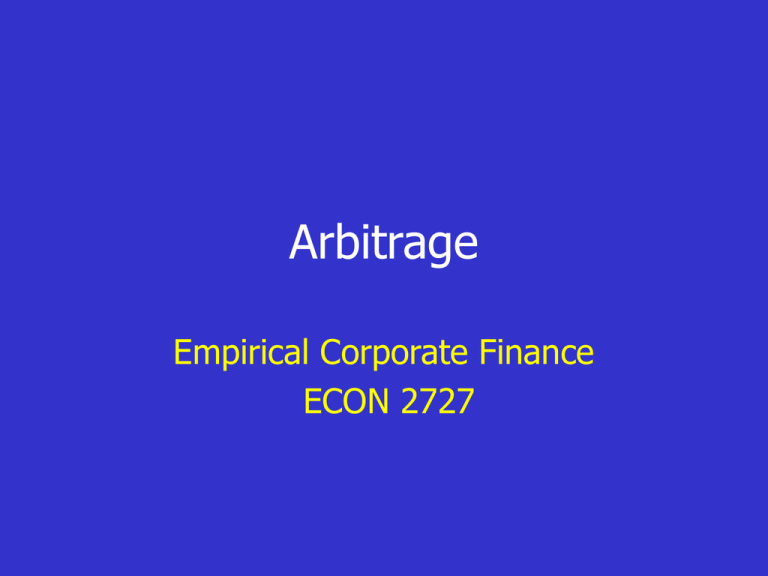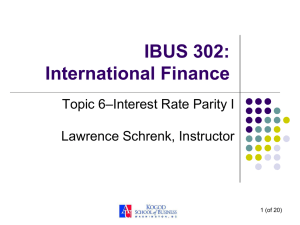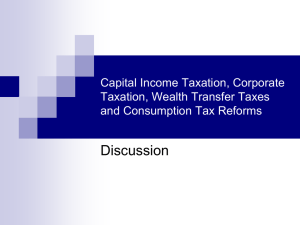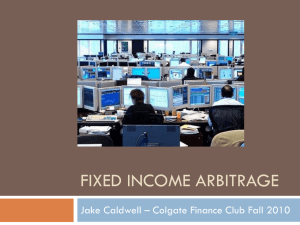Arbitrage - HBS People Space
advertisement

Arbitrage Empirical Corporate Finance ECON 2727 Core Concepts • • • • • Law of One Price Market Efficiency Equilibrium Arbitrage Limits to Arbitrage Arbitrage in Real Asset Markets Arbitrage • An investment strategy that guarantees a positive payoff in some state, with no possibility of a negative payoff, no net investment, and at arbitrary scale Money Machine • Arbitrage opportunities are inconsistent with common notions of equilibrium Law of One Price • Portfolios with the same payoff in every state must have the same price • Consequence of no arbitrage opportunities • Key to law of one price is perfect substitutes (exact same payoffs) • Underlies the MM Propositions Efficient Markets Hypothesis • Efficient Markets Hypothesis (EMH) At each point in time, prices for all securities fully reflect all available information (Fama (1970)) • Otherwise, profit opportunities exist (although maybe risky --- risk arbitrage) Market Efficiency • This notion of efficiency requires that capital markets are competitive and dominated by rational investors • The strong-form of the EMH also assumes that information and transaction costs are zero Equilibrium Arbitrage • Grossman and Stiglitz (1980) • When arbitrage is costly, prices cannot fully reflect all information --- no incentive to bear the cost of information gathering, if there is no compensation for bringing information into prices • EMH*: prices reflect information within bounds of information and transaction costs Limits to Arbitrage • • • • Imperfect information Transaction costs Agency Noise traders Real-world “arbitrage” is both risky and capital intensive Limits to Arbitrage • When there is uncertainty over the economic nature of an apparent mispricing and it is at least somewhat costly to learn about it, arbitrageurs may be reluctant to incur the potentially large fixed costs of entering the business of exploiting the arbitrage opportunity (Merton (1987)) • Uncertainty over the distribution of arbitrage returns will deter arbitrage activity until would-be arbitrageurs learn enough about the distribution to determine that the expected payoff is large enough to cover the fixed costs of setting up shop. • Even with active arbitrageurs, opportunities may persist while the arbitrageurs learn how to best exploit them. Limits to Arbitrage • Imperfect information and market frictions can encourage specialization, which limits the degree of diversification in the arbitrageur’s portfolio and causes him to bear idiosyncratic risks for which he must be rewarded • Fundamental risk - a purely random chance that prices will not converge to fundamental value will cause a highly specialized arbitrageur to invest less and therefore make arbitrage less effective • Financing risk - even if prices eventually converge to fundamental values, the path of convergence may be long and bumpy. If the arbitrageur does not have access to additional capital when security prices diverge, he may be forced to prematurely unwind the position and incur a loss (DeLong, Shleifer, Summers, and Waldman (1990), Shleifer and Summers (1990), Shleifer and Vishny (1997)). Limits to Arbitrage • Key to SV (1997) limits to arbitrage argument is agency relation between investors and money manager (Performance-Based Arbitrage) – Arbitrage is least effective when it is needed most, and may even compound mispricing – Financing constraint binds precisely when opportunities are good because investors cannot determine whether the need for more capital is because opportunities have improved or manager is incompetent Liquidity & Asset Fire Sales • When financing constraint binds, one option is to sell assets • If assets are illiquid, a quick sale may require a discount to fundamental value • Moreover, if asset is specialized and natural buyers are also constrained, then only potential buyers are outsiders who do not value asset as much Asset liquidity can be an important cost of leverage and therefore a potential determinant of capital structure Is there a risky arbitrage opportunity buying distressed assets? Liquidation Values and Debt Capacity (Shleifer-Vishny (1992)) • When firms have trouble meeting debt payments and sell assets or are liquidated, the highest valuation potential buyers of these assets are likely to be other firms in the same industry. • But these firms are themselves likely to have trouble meeting their debt payments at the time assets are put up for sale if the shock that causes the seller’s distress is industry- or economy-wide. • Assets may have to be sold to industry outsiders who do not know how to manage them well and fear overpaying. • As a result, the outsider will pay a lower price for the asset than would an industry insider. Empirical Research • • • • • Event Studies Long-term Event Studies Price Pressure Limits to Arbitrage Asset Fire Sales Event Study • What is the average wealth effect of an event? • Measure the “abnormal” return, or stock price reaction, to the announcement of the event (initial release of information) • Either assumes or tests: – Market Efficiency – Model of Expected Returns E[Ri,t] Event Study Methodology Estimation Window [ Event Window ] ( ) 0 • Market Model: E[Ri,t] = a + b E[RM,t] • Regress Ri on RM to estimate a and b • ARi,t = Ri,t - E[Ri,t] = Ri,t – a – b RM,t • Sum ARi,t over event-window to get CAR • Average over CARi Time Event Study • Avg Wealth Effect = Mean CAR • Std Error = std(CAR) / sqrt(N) • t-statistic = mean / std error • Campbell, Lo, MacKinlay (1997) Ch. 4 • Brown and Warner (1980, 1985) Empirical Considerations • Data – Get the correct announcement dates • Shorter the event window, less important the model of E[R] • 3-day E[R] 0 • Estimate parameters during a “normal” period • Some events may have unusual pre-event periods (i.e. mergers tend to be announced after large stock price runups of acquirers) Long-term Event Studies • Don’t do it • Long event window (3 to 5 years) • Requires a model of 3-yr expected returns • Multi-year abnormal returns are not independent • Failure to account for positive cross-correlation of individual abnormal returns will lead to overstated test statistics Bootstrapped Distribution of mean(BHAR) for SEOs Mean BHAR Mitchell and Stafford 2000, “Managerial Decisions and Long-Term Stock Price Performance,” Journal of Business Long-term Event Studies • Buy-and-hold abnormal returns (BHAR) • Typically assumes independence • Provides estimate of mean multi-year abnormal return, but statistical inference is difficult • Calendar-Time Portfolio Approach • Automatically accounts for cross-sectional correlations • Provides reliable estimates and inferences on a feasible investment strategy Calendar-Time Portfolios • Identify firms that have completed an event within the past X months • Create a portfolio of these firms • Weighting scheme • Analyze performance of this portfolio • Model of expected returns • Variation in the time series of portfolio returns automatically accounts for the cross-sectional correlations of the individual securities • Represents a realistic investment strategy • Can you make money doing this? Price Pressure Around Mergers • Acquirers in cash mergers have announcement period reactions of 0% to 1% • Acquirers in stock mergers have announcement period reactions of –2% to -3% • Common explanation is information or agency • Stock is overvalued • Mergers are bad • Is this really the reason? • Are we just labeling the “error” term an information effect? Another Story • Merger arbitrageurs push acquirers’ stocks down around merger announcements – Merger arb trading around mergers: • Always buy target • Short-sell acquirer in stock mergers, but not in cash mergers • Short-selling could cause downward price pressure on acquirer stock and partially explain negative reaction • Information is simultaneously being released, so hard to distinguish stories Insight: 2 Types of Stock Mergers • Fixed-exchange ratio stock merger • Acquirer offers to exchange X shares for each target share • X is fixed and known at announcement • Arbs short-sell X shares acquirer stock immediately for each target share they are long • Floating-exchange ratio stock merger • Acquirer offers to exchange $Y worth of acquirer stock for each target share • X is floating until right before merger completion when it gets fixed based on average acquirer stock price over a several day “pricing period” • Arbs short-sell acquirer stock during pricing period, not at announcement Floating-Exchange Ratio Stock Mergers • At Announcement: 0.5% – Looks like cash merger – Information coming out • During Pricing Period: -3% – Looks like traditional stock merger – Little information – Lots of short selling Are Arbs Really Responsible? • If negative reaction partially due to arb short selling, then short interest should follow pattern • Increase around announcement for fixed-exchange stock mergers • No change at announcement for cash and floatingexchange stock mergers • Trading activity of other professional investors should create price pressure • Index funds rebalance at merger closing for certain types of stock mergers • No rebalancing for others How much due to Arbs? • Estimate roughly 50% – Predict change in short interest due to merger arbitrageurs – Use predicted value as a control in a crosssectional regression of CARs – How much does this control affect estimate? Implications • Mergers not so bad • Must be careful interpreting event studies when event triggers trading • More evidence on the existence of price pressure (downward sloping short-run demand curves) Behind the Scenes • Topic Selection • Framing Paper • Price pressure • Mergers • Event studies • Data • “Always plot the data!” (Arnold Zellner) • Methodology Limited Arbitrage in Equity Markets • Negative Stub Values (a typical case) • Parent firm carves out subsidiary and retains 80%+ ownership – Allows for a tax-free distribution of remaining shares to parent shareholders • MVParent < 0.8 x MVSubsidiary • Implies that parents “Stub” assets are negative Limited Arbitrage in Equity Markets • Arbitrage? • Strong link between 2 securities (nearly perfect substitutes) • Is this risk free? • Is there a capital requirement? • Can you make money? December 4, 1998 Creative Computer’s Market Value Balance Sheet Stake in Ubid Other Assets Stub (Plug) Assets $352M ? -$80M $272M Liabilities Equity $3M $269M Liab & Equity $272M Creative Computers owns 7.33M shares (80%) of Ubid stock Creative Computers has 10.25M shares outstanding Owner of 1 share of Creative Computers effectively owns 0.715 shares of Ubid Strategy: Buy 1 share of Creative Computers at $26.25 / shr Short 0.715 shares of Ubid at $48.00 / shr ($34.34) Requires an investment of $30.29 (50% of the long & 50% of the short) June 7, 1999 Creative Computer’s Market Value Balance Sheet Stake in Ubid Other Assets Stub (Plug) Assets $249M ? $93M $342M Liabilities Equity $3M $339M Liab & Equity $342M Creative Computers distributes shares of Ubid to shareholders in a tax-free spinoff Value of long position in Creative Computers has changed from $26.25 to $32.63 Value of short position in Ubid has changed from $34.34 to $24.02 Total gain of $16.70 on $30.29 initial investment (55% return over 6 months) Data • 82 negative stub situations (1985-2000) • Use 2 definitions of negative stub value • SDC Database of IPOS, where another publicly traded firm owned shares beforehand • Search financial press for extreme relative value situations (make sure it satisfies condition above) • Need shares outstanding for both firms and shares owned • CRSP is usually wrong on IPO shares outstanding • Collect from 10Ks/10Qs Path to Convergence Figure 1 Creative Computers/UBID Arbitrage $160 Margin Call Margin Call #4, 12/23/98 $140 #3, 12/22/98 Margin Call $120#2, 12/21/98 UBID (x .72) $100Margin Call #1, 12/18/98 Creative Computers $ per share $80 $60 Invest 12/9/98 $40 $20 $0 12/1/98 1/1/99 2/1/99 3/1/99 4/1/99 5/1/99 6/1/99 Impediments to Arbitrage • Link is unfavorably severed • 30% of all situations terminate without convergence • Path to convergence is too long • Range from 1 day to 2,796 days • Even with convergence, investment can underperform RF when the path is long • Path to convergence is too bumpy • Mispricing can worsen before it disappears • Returns to a specialized arb would be 50% higher if path was smooth rather than as observed • Imperfect Information • What is known ex-post is not known ex-ante Portfolio Values Figure 2 Daily Portfolio Values of Negative Stub Investments Rule 1 --- Buy Threshold = 1.25; Sell Threshold = 1.0 (No Maintenance Requirements) $20 $15 $10 $5 $1 Initial Investment MALL / UBID Spread Widens $0 9/12/1986 -$5 -$10 9/12/1988 9/12/1990 9/12/1992 9/12/1994 9/12/1996 11 out of 15 Spreads Widen 9/12/1998 9/12/2000 Imperfect Information • Be careful interpreting perfect capital market anomalies • Consider setting up a fund to exploit anomaly • Uncertainty seems to be a major impediment to arbitrage • Large stock price reaction to the resolution of uncertainty Conclusions • Significant costs limit arbitrage activity • Tests our faith in market forces keeping prices at fundamental values • Market forces are working hard to keep markets efficient, but efforts are sometimes ineffective Asset Fire Sales • Pulvino (1998) “Do Asset Fire Sales Exist? An Empirical Investigation of Commercial Aircraft Transactions,” Journal of Finance • Empirical test of SV (1992) • Do financial constraints force firms with industry-specific assets to liquidate assets at discounts to fundamental value? Evidence • Capital constrained firms sell used aircraft at substantial discounts to estimated fundamental value • Capital unconstrained firms purchase used aircraft when prices are low and refrain from purchasing when prices are high Priors • Previous research examined announcement period stock price reactions of buyers and sellers • Seller has negative returns before sale • Positive reaction to announcement for both buyer and seller • If sale is not actually completed, seller loses gain Asset sales represent reallocations from low to high value users • Positive reaction to seller seems inconsistent with a forced sale Comments • Key to paper: Obtain actual transaction prices of used aircraft sales and then compare to estimates of fundamental value • Estimate fundamental value with hedonic pricing model (regress price on asset characteristics) • Concern: Do the observed characteristics fully capture the “quality” of the aircraft • AGE and STAGE (engine noise level) are proxies • What if constrained airlines cutback on maintenance, use cheap replacement parts, and/or falsify records? • Maybe just getting a low, but fair price for a crappy plane








